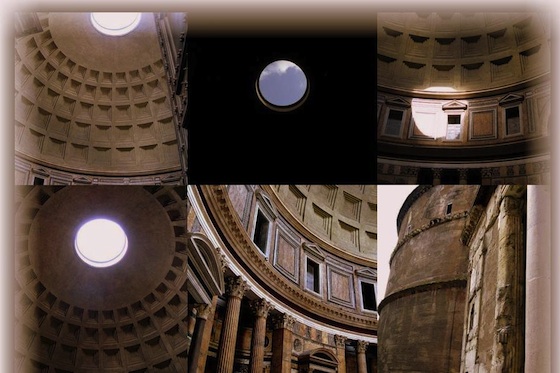
The awe from standing in the Pantheon and looking up at the oculus is inadequate for words, and yet I will attempt to put into words the rush of emotion from the sight of the last standing Roman architectural feat. I will ascribe words to a human achievement built as if by a miracle some two thousand years ago, and one that civilization has only managed to lose the ability to build again, much less surpass with the advancements in technology and industrialization. It is an achievement of enormous measures that left me feeling deeply feeble as a human being.
Certainly words will be inadequate, and for anyone who will not experience the Pantheon in all its glory, no depiction of it will come close to doing it the justice that your eyes will do. That is my disclosure for you.
Here are my reflections on my most momentous memories from Italy: the magnificent Pantheon in Rome.
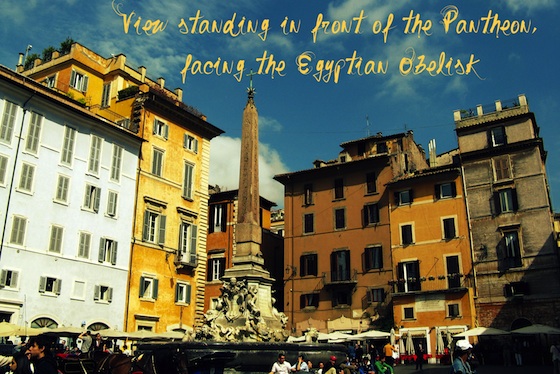
We arrived in the Piazza della Rotonda in the morning of a beautiful day in Rome during late May in 2008. The sun was bright, the Piazza barely showing signs of activity, with the sounds of hustle and bustle still a few hours away. The center of Piazza boasts a large obelisk, standing on top of a small fountain, tall, straight, and with dignity. If only the obelisks in Rome’s Piazzas had eyes and ears to tell of what they witnessed.
I think of the Romans who marched into Egypt with conceited authority, destroying, killing, and robbing others and taking what they deemed necessary for their own empire. I imagine they came upon the obelisks, considering them “ancient”, “antiquated”, a piece of history to cherish in present day Roman Empire of the time, and so they decided to uproot and bring them back to Rome. Ancient to the Romans. And how many years ago was it that the obelisk itself was built under the blazing Egyptian sun? It is so hard to fathom how the Roman Empire, which ruled over two thousand years ago, considered something old and ancient.
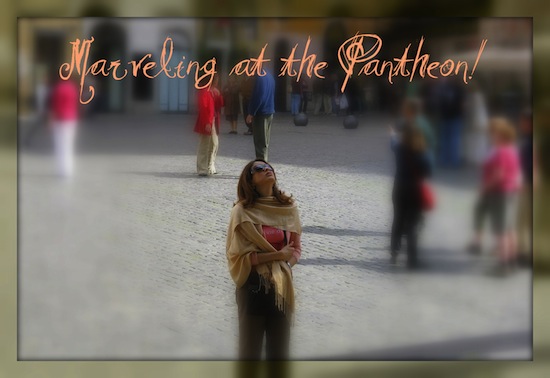
The relativity of time is funny and brutal . Decades, centuries and ages have passed since the obelisks arrived in Rome and found a new home in the busy bustling Piazzas of Italy. This particular obelisk in Piazza della Rotonda is especially lucky, because it faces the Temple of all the Gods, the majestic Pantheon, every day of its existence. She leaves me green with envy, such a view to bask in and reflect on, such a sharp reminder of the grandeur of the Roman Empire and achievement of man.
We soon found ourselves drawn to the quiet majesty of the Pantheon. There, in the Piazza, I felt the minutes slow down, and with it, my body and movements slowed down considerably. My eyes were overwhelmed with the enormous task of looking, studying, digesting, and marveling at everything before me. The eight equidistant columns covering the facade of the Pantheon seemed to grab a hold of me; I did not want to miss surveying every column, the sheer enormity of each one aside, I wanted to study the art and design on each column top. Alas, I am short and small, and the Pantheon is much too demanding to the feeble eye.
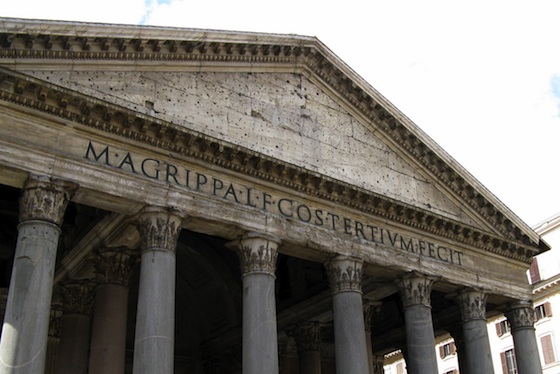
The inscription on the facade reads:
“M·AGRIPPA·L·F·COS·TERTIVM·FECIT“, written in Latin: Marcus Agrippa, Lucii filius, consul tertium fecit translated to “‘Marcus Agrippa, son of Lucius, Consul for the third time, built this.”
History tells us the Pantheon was rebuilt twice, and so it was build three times. Marcus Agrippa built the original in 27 BC, which was destroyed in a huge fire in 80 AD, rebuilt again by Titus Flavius Domitianus only to be burned in a second fire in 110AD, and rebuilt for a third and last time by Hadrian in 126 AD. Imagine the fortitude and ambition in undertaking a task of rebuiding the Pantheon three times. History is more surreal than fiction sometimes.
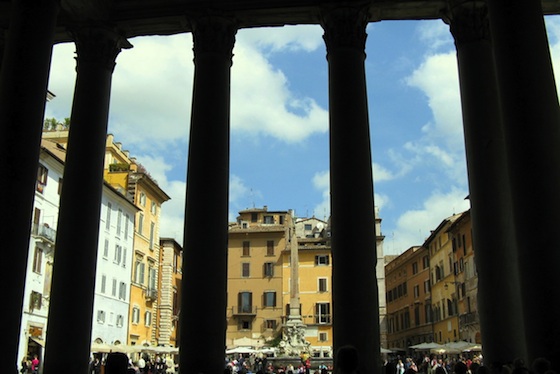
After the first 30 minutes of marvel and disbelief, I stepped through the gigantic bronze doors and entered the Pantheon. Looking up was my first immediate instinct, not so much to see the oculus as much as to take in the entire rotunda with one quick glance. The dome is an engineering marvel. The oculus is breathtaking. There is a heavenly and spiritual quality surrounding the dome opening into the blue skies, and the strong rays of bright light shining inside, coming in through the oculus, displayed in the shape of a moving circle with the hours of the day.
Certainly, the oculus was not built for mere enjoyment of the sun and light. The opening plays a crucial role in structural design and engineering of the dome, and so precisely well-done it is that it stands erect and stable to this day, unyielding to age or weather or neglect. The oculus symbolizes an entrance into the heavens above, a solid indication of unwavering faith and belief that must have played a key role in the building of this dome.
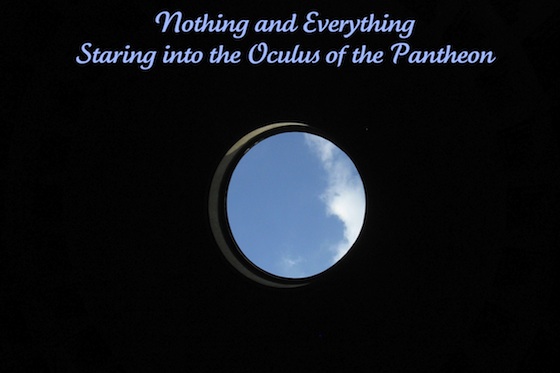
Traveling changes your mind and expands your horizons! If you like to see the other travel stories here, check the On the Road category.
I could have spent hours inside the Pantheon. Small and melancholy mark the most distinct feelings I remember, followed naturally by awe and amazement that knew no end. The rotunda is left open for the most part save for a few rows of benches facing the church altar for the regular Catholic services held here. The inside design is surreal in detail. The beauty of the art on marble and stone, the decor some of which was lost or destroyed in the Medieval time, marks every corner of the rotunda from floor to base of the dome.
The Pantheon was dedicated to all the Gods, a symbol of Paganism practiced in the Roman Empire, and it also happens to be the first Pagan temple to be converted to a Christian Church – and so it was restored and looked after again. Paganism or Christianity, I care not which it represents, I only care that it be forever kept at a safe distance from those who wish to destroy the miracles that are built by mankind. Perhaps today, the Pantheon has come to represent a symbol beyond a sacred sleeping tomb for Christian or Renaissance figures buried, or a symbol of worship of all the Roman Gods. Perhaps, it symbolizes the ultimate achievement of man possible, the injustice of the imposed labor notwithstanding.
The beauty of this structure is moving to the core. What effort, what miraculous effort it must have taken, how many hundreds or thousands of Roman slaves were sacrificed before the structure went up not once but the three times in the span of some 200 odd years. And what complete understanding and application of engineering and architecture the Roman Empire must have possessed to undertake the creation of the Pantheon. How those measures of incredible knowledge vanished with the fall of Roman Empire to throw Europe to the Dark Ages, and with it, into a gloom over civilization and humanity for hundreds of years to follow.
Over two thousand years ago, the Roman Empire understood science, engineering, architecture, in a depth that would not bless the rest of civilization for an agonizingly long time. I argue that we do not and will never understand the depth to which they understood and applied the beauty of engineering and architecture to their world, leaving indelible marks behind for all generations to see, to admire, to behold.
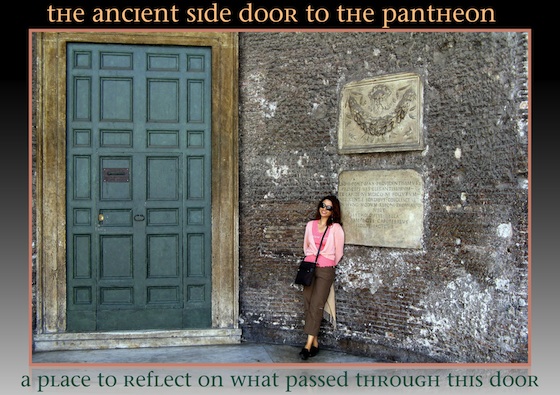
 I am Farnoosh, the founder of Prolific Living. So glad you are here. My mission is to empower you to unblock your creative genius to live your dream life.
I am Farnoosh, the founder of Prolific Living. So glad you are here. My mission is to empower you to unblock your creative genius to live your dream life.